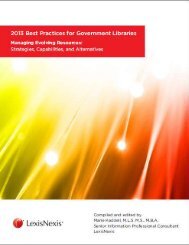2012 Best Practices for Government Libraries
2012 Best Practices for Government Libraries
2012 Best Practices for Government Libraries
Create successful ePaper yourself
Turn your PDF publications into a flip-book with our unique Google optimized e-Paper software.
94<br />
BEST PRACTICES <strong>2012</strong><br />
student; one person will usually take charge of creating the tutoring schedule. If their<br />
schedule allows, each tutor will usually be able to tutor at least once a week.<br />
Curriculum and Materials<br />
The purpose of the ESL program is to teach English in a one-on-one tutor/student<br />
situation to the contract cleaning staff in our building. Some of our tutors speak Spanish,<br />
and although it can be helpful and fun to speak Spanish to the students, we urge the<br />
tutors to use English as much as possible; improving students’ language skills is the<br />
priority and the core of the curriculum. An integrated approach of listening, speaking,<br />
reading, and writing English that is relevant to the students’ daily work and life<br />
experiences and needs is encouraged. Tutors in the workplace create a supportive<br />
environment in which the students participate in activities and exercises that enable them<br />
to improve their English language skills quickly. Emphasis is placed on increasing<br />
vocabulary and proper pronunciation. The stress is heaviest on conversational English.<br />
The ESL curriculum covers several areas that the students wish to concentrate on and<br />
improve: workplace communication, daily activities, and studying <strong>for</strong> citizenship.<br />
The primary materials currently being used are: “The Ox<strong>for</strong>d Picture Dictionary Bilingual<br />
Edition (Spanish-English)”; “Ingles Hecho Facil”, a workbook <strong>for</strong> Spanish speakers; and<br />
civics flash cards from the US Citizenship and Immigration Service. Many other materials<br />
are being used to instruct students including workbooks, motor vehicle materials,<br />
newspaper advertisements, newspaper articles, grammar exercise sheets, and basic<br />
numerical calculations.<br />
Conclusion<br />
The DOJ Library Staff ESL Workplace Program is a partnership between DOJ employees<br />
(tutors) and the contract cleaning employees (students). The existence of this program<br />
depends on the continued support and cooperation of these groups, along with<br />
management support. In the past year, ESL tutoring programs have been initiated in two<br />
additional DOJ buildings following the same model as the original program that began in<br />
the DOJ Patrick Henry Building in 2000. Now that these programs have been in existence<br />
<strong>for</strong> several months, there is a discernible improvement in the English language<br />
conversational skills of the cleaning staff students. I expect these programs to continue<br />
as long as there is a need and desire on the part of the cleaning staff to improve their<br />
English language skills and a desire by DOJ employees to give something back to their<br />
community and be a part of this rewarding program. A number of the tutors have<br />
expressed their belief that it is a “win-win” situation <strong>for</strong> all participants. One tutor wrote,<br />
“To watch our student improve so rapidly and be so eager <strong>for</strong> more in<strong>for</strong>mation and so<br />
grateful <strong>for</strong> our help is one of the most rewarding experiences I have ever had.” So far, at<br />
least one of our students has achieved her goal of becoming a U.S. citizen. It is our hope<br />
that, as we continue to experience success, this program will become a model <strong>for</strong> other<br />
ESL workplace programs throughout the Department of Justice and other federal<br />
government agencies.



